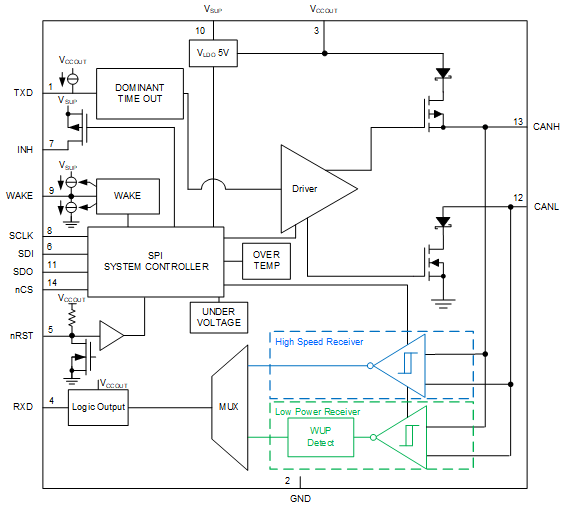SFFS141 December 2021 TCAN1167-Q1
5.4 TCAN1167-Q1 Component Overview
The TCAN1167-Q1 is a high speed Controller Area Network (CAN) system basis chip (SBC) that meets the physical layer requirements of the ISO 11898-2:2016 high speed CAN specification. The transceiver supports both classical CAN and CAN FD networks up to 8 megabits per second (Mbps).
The TCAN1167-Q1 supports a wide input supply range and integrates a 5-V LDO output. The 5-V LDO output (VCCOUT) supplies the CAN transceiver voltage internally as well as additional current externally.
The TCAN1167-Q1 allows for system-level reductions in battery current consumption by selectively enabling the various power supplies that may be present on a system via the INH output pin. This allows an ultra-low-current sleep state where power is gated to all system components except for the TCAN1167-Q1, while monitoring the CAN bus. When a wake-up event is detected, the TCAN1167-Q1 initiates system start-up by driving INH high.
 Figure 5-1 TCAN1167-Q1
Block Diagram
Figure 5-1 TCAN1167-Q1
Block Diagram| Potential Failure Point | Potential Failure Point Description | Section |
|---|---|---|
| 1 | CAN communication | See Section 5.3.1.1, Section 5.3.1.2, Section 5.3.1.3, Section 5.3.2.1 |
| 2 | Supply voltage rail monitoring | See Section 5.3.2.1, Section 5.3.2.2, Section 5.3.2.3, Section 5.3.2.4 |
| 3 | SPI/Processor communication | See Section 5.3.1.4, Section 5.3.3.1, Section 5.3.3.2, Section 5.3.3.3, Section 5.3.3.4, Section 5.3.4.1 |
| 4 | EEPROM | See Section 5.3.4.1 |
| 5 | Floating pins | See Section 5.3.5.1, Section 5.3.5.2, Section 5.3.5.3, Section 5.3.5.4 |